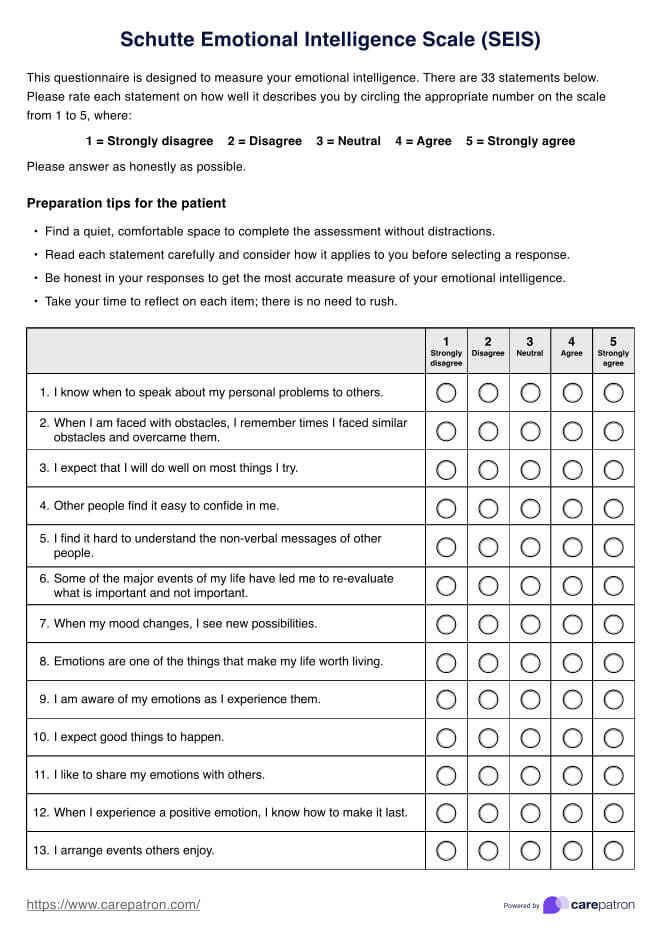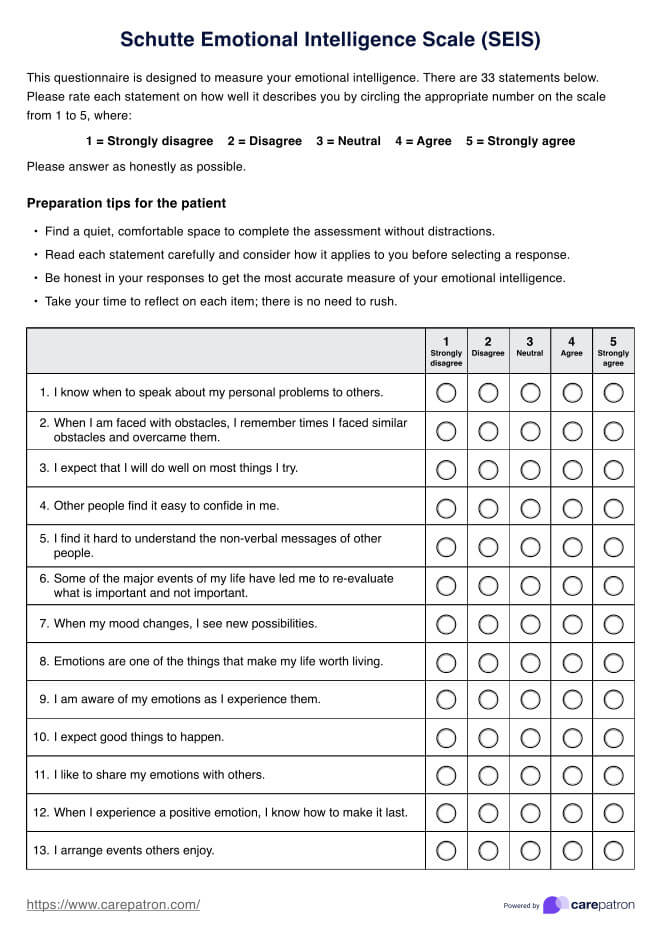Schutte Emotional Intelligence Scale
Enhance your emotional intelligence with the Schutte Scale. Elevate patient care, strengthen team collaboration, and make informed decisions. Read more and download the free PDF.


What is the Schutte Emotional Intelligence Scale (SEIS)?
The Schutte Emotional Intelligence Scale (SEIS), also known as the Schutte Self-Report Emotional Intelligence Test (SSEIT) is a 33-item self-report measure that assesses emotional intelligence using a 1 (strongly disagree) to 5 (strongly agree) scale. It measures four factors of emotional intelligence: emotion perception, utilizing emotions, managing self-relevant emotions, and managing others' emotions (Schutte et al., 1998). Schutte and her colleagues founded this inventory on the model of the emotional intelligence developed by Salovey and Mayer in 1990.
The SSEIT has demonstrated good reliability, with Schutte et al. reporting a reliability rating of 0.90 for their emotional intelligence scale. However, the utilizing emotions sub-scale has shown poor reliability in some studies. The SSEIT has also shown mediocre correlations with constructs like self-estimated EI, the Big Five EI scale, and life satisfaction (Petrides & Furnham, 2000).
Validation studies have supported the SSEIT's four-factor structure in various cultural contexts, including South Africa (Jonker & Vosloo, 2008) and Zambia (Musonda et al., 2019). These studies found the instrument reliable, with Cronbach's alpha coefficients ranging from 0.74 to 0.79.
What is the goal of the SEIS?
The primary goal of the SEIS is to provide a reliable and valid measure of the characteristic emotional intelligence. It aims to help individuals:
- Recognize and understand their own emotions.
- Manage and regulate emotions effectively.
- Understand and influence the emotions of others.
- Utilize emotions to solve problems and make decisions.
The SEIS contributes to personal development, improved interpersonal relationships, and enhanced emotional well-being through these objectives.
How is the SEIS scored?
Scoring the SEIS involves summing the ratings for all 33 items. Each item is scored on a scale from 1 (strongly disagree) to 5 (strongly agree), resulting in a total score that reflects an individual's overall emotional intelligence. The SEIS doesn't differentiate between subscales, instead providing a single comprehensive score. Higher scores indicate greater emotional intelligence, while lower scores suggest areas for potential growth and development.
Next steps after using this scale
Once the SEIS assessment is complete, there are several steps psychologists and healthcare professionals can take:
- Interpret the results: Analyze the total score to identify strengths and areas for improvement in emotional intelligence.
- Develop personalized interventions: Create tailored strategies to enhance emotional skills based on the individual's score.
- Monitor progress: Use the SEIS periodically to track changes and improvements in emotional intelligence over time.
- Educate and empower clients: Provide clients with insights and resources to help them understand and develop their emotional intelligence.
Schutte Emotional Intelligence Scale
Schutte Emotional Intelligence Scale
How to use our Schutte Emotional Intelligence Scale template
To make the SEIS assessment process seamless, we offer a user-friendly template that professionals can integrate into their practice. Here's a step-by-step guide on how to utilize the SEIS template:
Step 1: Download the template
You can access our free SEIS template from the resources tab on our website. The template includes the 33-item self-report measure and instructions for administration and scoring.
Step 2: Administer the assessment
Distribute the SEIS template to your clients and guide them through the self-report process. Ensure they understand the 5-point Likert scale, ranging from "strongly disagree" to "strongly agree," and encourage them to respond honestly.
Step 3: Score and interpret the results
Use the included scoring guide to calculate the total SEIS score and the scores for the four sub-scales: emotion perception, utilizing emotions, managing self-relevant emotions, and managing others' emotions. Interpret the results in the context of your client's needs and goals.
Step 4: Implement personalized interventions
Develop tailored interventions based on the assessment outcomes. This may involve strategies to enhance emotional self-awareness, improve emotion regulation, or strengthen interpersonal skills. Collaborate with your client to create a plan for personal growth and development.
Using our SEIS template can streamline your emotional intelligence assessment process and provide your clients with valuable insights to support their personal and professional development. The template's user-friendly design and comprehensive scoring guide make it a valuable tool for mental health professionals, coaches, and educators.
How this scale benefits mental health professionals
The SEIS offers several benefits for mental health professionals:
- Enhanced client understanding: Gain deeper insights into clients' emotional functioning, enabling more accurate diagnoses and effective treatment plans.
- Customized interventions: Develop personalized strategies to address specific emotional intelligence deficits, leading to better therapeutic outcomes.
- Progress monitoring: Regular SEIS assessments allow for ongoing tracking of clients' emotional development, facilitating adjustments to treatment as needed.
References
Jonker, C. S., & Vosloo, C. (2008). The psychometric properties of the Schutte Emotional Intelligence Scale. SA Journal of Industrial Psychology, 34(2), 21-30. https://doi.org/10.4102/sajip.v34i2.689
Musonda, A., Shumba, O., & Tailoka, F. P. (2019). Validation of the Schutte Self Report Emotional Intelligence Scale in a Zambian Context. European Journal of Psychological Assessment, 36(1), 1-8. https://www.ejper.com/validation-of-the-schutte-self-report-emotional-intelligence-scale-in-a-zambian-context
Petrides, K. V., & Furnham, A. (2000). On the dimensional structure of emotional intelligence. Personality and Individual Differences, 29(2), 313-320. https://doi.org/10.1016/S0191-8869(99)00195-6
Schutte, N. S., Malouff, J. M., Hall, L. E., Haggerty, D. J., Cooper, J. T., Golden, C. J., & Dornheim, L. (1998). Development and validation of a measure of emotional intelligence. Personality and Individual Differences, 25(2), 167-177. https://doi.org/10.1016/S0191-8869(98)00001-4
Commonly asked questions
Emotional intelligence involves recognising, understanding, managing, and utilising emotions in oneself and others.
High emotional intelligence is linked to better mental health, stronger relationships, and increased success in personal and professional settings.
While the SEIS is primarily designed for adults, it can be adapted for adolescents.
The SEIS can be administered periodically to monitor changes in emotional intelligence and assess the effectiveness of interventions.

.jpg)



















-template.jpg)


















































































